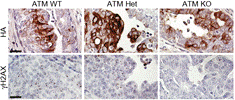Veterinary and Biomedical Sciences, Department of
Document Type
Article
Date of this Version
2007
Citation
Clinical Immunology (2007) Supplement, 123: S152-S153,
Abstract
Treatment with ex vivo generated regulatory T cells (Treg) has been regarded as highly attractive therapeutic approach for autoimmune diseases. However, the dynamics and function of T-reg in autoimmunity are not well understood. Thus, we developed Foxp3gfp “knock-in” mice and myelin oligodendrocyte glycoprotein (MOG)35–55/IAb tetramers to track autoantigen-specific effector T cells (T-eff) and T-reg in vivo during experimental autoimmune encephalomyelitis, an animal model for multiple sclerosis. Following immunization with the encephalitogenic peptide MOG35–55 emulsified in complete Freund's adjuvant, MOG35–55-tetramer-reactive, Foxp3+ T-reg expanded in the peripheral lymphoid compartment and readily accumulated in the central nervous system (CNS), but did not prevent the onset of disease. During disease onset, the MOG-tetramer+ T-eff population in the CNS increased faster than the population of antigen-specific T-reg. At the peak of disease, the ratio of T-reg vs. T-eff was 1:17 which dramatically changed into 1:2 at the beginning of recovery. Foxp3+ T-reg isolated from the CNS were fully competent in suppressing naive MOG-specific T cells. However, Foxp3+ T-reg failed to control encephalitogenic T-eff which in contrast to T-eff from the peripheral immune compartment, secreted IL-6 and TNF when they were isolated from the CNS at the peak of disease. Our data suggest that in the face of inflammation, the regulation of autoimmunity by CD4+Foxp3+ T-reg in situ may not be accomplished simply by changing the numerical balance of antigen-specific pathogenic vs. regulatory T cells, but may require the control of tissue inflammation as well.
Included in
Biological Phenomena, Cell Phenomena, and Immunity Commons, Medical Biochemistry Commons, Medical Molecular Biology Commons, Nervous System Diseases Commons



Comments
Copyright 2007, Elsevier. Used by permission. Abstract of a poster presented at FOCIS 2007, San Diego, California, June 7-11, 2007, held by the Federation of Clinical Immunology Societies.